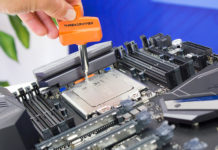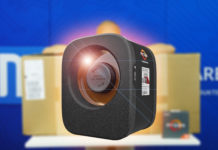We put AMD’s flagship Athlon 64 FX-57 in the hands of Sweden’s best overclocker Robert Kihlberg to test this extremely expensive processor’s capacity with different types of cooling.
Everyone who has some interest in computers and their hardware, and have built one themselves probably knows about AMD and their CPU FX-Series. But only a few people own one. The only ones that buy this CPU are the hardcore enthusiasts, despite the fact that they already have a high end CPU, just to be able to squeeze the most out of their systems.
Previously we have written deeper about the architecture of the AMD Athlon64. This article is available for reading here, and an article about the AMD FX-55 is available here. The obvious difference from the FX-55 is, not unexpectedly, an increase in the frequency for the original CPU. AMD has changed the manufacturing process from 130nm to 90nm and have started using the new “San Diego”-core. Further improvements from the 130nm FX-55 are various adjustments and add-ons to the integrated memory controller. We will not dwell further into these subjects but will concentrate more on how to further improve the performance of this CPU. We have three different cooling methods, air cooling, water cooling and phase change cooling, which will help us test the boundaries of what this CPU can perform.
We will begin by introducing our test system and how we intend to run these tests.
 |
|
Test system |
|
| Hardware | |
| Mainboard | Abit Fatal1ty AN8 SLI, BIOS 17 |
| Processor | AMD FX-57 (San Diego, 0512MPMW) |
| Memory | Mushkin Black Level2 PC3500 2x256Mb (BH-5) |
| Video card | nVidia GeForce 6600GT |
| Power supply | OCZ PowerStream 520W |
| Software | |
| Operating system | Windows XP (SP2) |
| Drivers | ForceWare 77.77 nForce 6.66 |
| Monitoring program | Abit EQ |
| Test program | SuperPi 1.1e |
As you can se, we won’t be using many test programs. The idea with this article is not to gain actual performance from several different programs, but rather to establish stability levels. Talking about different types of stability levels might sound strange to those of you who are familiar with over-clocking, electrical components should simply, do right or wrong. This is the case on a micro-level, but thanks to different kinds of error corrections it is possible to either correct the errors or make the system report what is wrong. When the CPU is overclocked too much, there are too many errors generated which causes the system to freeze or restart. Overclockers can make the CPU work with better signals and therefore, stopping it from counting wrong by increasing the voltage or improving the cooling.
The aim of this article is that the CPU should be able to calculate Pi with one million decimals using the SuperPi program. This is relatively low demand on the stability, and therefore we will, for each cooling type, declare in what frequency the CPU can calculate Pi with 32 million decimals. This test demands a lot more of the CPU. We’re not using any 3D-program in our tests, because this will add another performance factor. A fast video card relieves the pressure of the system in a different way than a slow one.
Enough prerequisites, on to the air cooling tests.
Air cooling, has lately had a rough time keeping the temperatures at bay, is without a doubt, the most common way of cooling a CPU. The FX-57 is one of the CPUs on the market that produces most heat and therefore puts heavy demands on the air cooler. The first cooler used in this test is the Zalman CNPS9500. This cooler is a sufficient substitute for the original cooler. Here are the results:
The CPU got through SuperPi 1M at 2942 MHz using the original voltage, and then scales 20 MHz linear after each 25mV increase. It levels out at 3120 MHz with a voltage of 1.625V. Increasing the tension further only makes the CPU hotter, which can create instability issues. Something worth noting is that this is an open-system with an air temperature of ~22C. We move on to another air cooler.
Now we’ve installed a ThermalTake Tower 112 with two 80mm Delta fans. Unlike Zalman’s cooler, this is not a cooler you want in your everyday computer. Testing this combination under optimal conditions (open window, 18C air temperature), demanded both earplugs and a jacket, which we luckily had access to. Here are the results:
Lowering the temperature and increasing the airflow made a difference in the performance. Like the previous, it stopped at 1.625V, but with a maximal frequency of 3168 MHz.
We tested at what level our second air cooler could go through a 32M calculation in SuperPi. A 32M calculation takes little over 20 minutes, compared to a 1M that takes about 20 seconds. This puts heavy demands on the efficiency of the cooling device. When performing a 1M calculation the heat sinks have enough “cooling”-energy in them, and the temperature will not increase that much during such a short period of time. Our loud cooling device had big problems keeping the temperature down and we had to decrease the voltage, thus also decreasing the frequency. Using 1.525V the test was at 2990 MHz. We can clearly see that you can put a heavy load on the CPU during short periods, but at high frequencies you have to decrease the load considerably to keep the CPU stable.
Next we have the water cooling tests.
We have reviewed the water cooling earlier; you can find the article here. It contains an Asetek Antarctica water block and a 3x120mm radiator. There was no problem enduring the sound volume from the fans, which ran at full speed. The air temperature from the radiator was 18C and the water temperature reached 22C. Let’s look at the results:
The water cooling had no problem beating the air cooled alternatives and gave us a constant frequency increase ranging from 15 to 20 MHz through every step. Because of this, we could reach higher voltages and thus higher frequencies. This increase in stability made us reach 3080 MHz at 1.55V in SuperPi 32M. We can clearly se that we have a bigger buffer to work with when using water cooling compared to when we use air cooling. The radiator was very efficient and the water temperature only increased by 1C at the end of the 32M test.
On page 5 we test some heavier equipment.
Air and water cooling only have the ability to decrease the temperature to room temperature, but what happens if we go far below room temperature? More close to 70C below room temperature. As you can see in the pictures, there are a lot more preparations when using a phase change cooled system. If you don’t insulate enough, you can find yourself with damaged hardware. We used grease on the components around the socket and insulating tape on both the front and the back. The phase change unit is the same one that we used at DreamHack this summer, but with an exception that we have a new evaporator and that the gas has been changed from R404A to R507. The unit is adjusted so that it, during full load, will receive optimal temperatures. The temperatures shown in the pictures are taken from the side of the evaporator. So, how does it perform?
Here we get a huge increase in the frequency! We pass the air cooling maximum already at the original voltage and with a slight increase we also pass the water cooling. Thanks to the cool temperatures, we get the CPU up to 3500 MHz but after that, it starts to get a bit more demanding. Using 1.70V, we just manage to pass SuperPi 1M at 3507 MHz. We lowered it a bit and managed to run SuperPi 32M at 3454 MHZ using 1.70V. The temperatures on the evaporator never exceeded -50C during the SuperPi 1M tests and during the 32M tests it didn’t get much hotter than -46C. This motherboard doesn’t support readings below 0C from the CPU, but we can agree that the CPU internally never reached over 0C.
Here we can see how the FX-57 performs at about 3.5GHz. We compile the results and take a closer look at them on the next page.

This is how it looks when we put the different values together. The scale starts at 2800 MHz which is the standard speed for the CPU. As we have discussed earlier, there is not a big difference between the air cooling and the water cooling. Optimally, these two cooling devices don’t go below room temperature and there is not a big difference when it comes to short tests. The air cooling starts to loose ground when it comes to extended tests like SuperPi 32M. We also saw that the water cooling is much better at conducting large masses of energy.
Our last cooling device is in a class of its own. What you gain in the performance is obvious. However, there are a few things to think about before you start using this cooling method. Temperatures below room temperature create condensation and you have to take careful measures when isolating if you want to run the system for a longer period of time. Also, a phase change consumes a lot more current than both air cooling and water cooling, but compared to a peltier system, it is more efficient and less energy consuming. Commercial systems consume 150W or more, while our homemade system is a bit over the top with a power consumption of 600W.
When it comes to over-clocking, one of the basic factors is to be able to increase the voltage. A higher voltage gives more clear signals to the CPU, while at the same time it increases the heat that the CPU emits. If we can cool the CPU properly, we can to a certain limit, increase the voltage. But if the cooling isn’t enough, the temperature will raise considerably, which increases the resistance in the CPU, which leads to worse signals, worse stability and lower over-clocking margins. The other basic factor is of course better cooling. Lower temperatures give, like a voltage increase, purer signals. As we can see in the diagram, phase change cooling not only give a constant higher frequency, but also reacts better to an increase in the voltage and therefore scales better than the two other alternatives.
We end this article by summarizing our conclusions.

The general conclusion is, without surprises: more cooling, more voltage. A bit more surprising is the so called cold-bugs that come up when an electrical circuit stops working because it’s to cold. Some CPUs, and even some of the never GPUs have this bug. Depending of what CPU you are using, this bug occurs at different temperatures, everything from -40C to -120C or lower. So far this is not common, when you use a single-step-system like ours. This is a challenge that has affected overclockers around the world, and we will probably se more of it in the future.
We hope that we have given you a well documented insight of how a CPU is affected by different types of cooling devices and what increases in performance you can expect. Partly with an FX-57 CPU, but also what increases in performance you get when changing from air to water or even a phase change.
Finally, we would like to thank AMD, whom has sent us this CPU for testing.



































Want to learn more about Forex?
Click here and receive a gift coupon
http://www.dmaforex.com